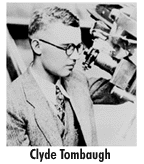The Search Continues
 The
observatory had a brand new telescope, but no one to spend time looking
for the ninth planet. It would be tedious work, conducting a photographic
search of the sky for a bare pinpoint of light.
The
observatory had a brand new telescope, but no one to spend time looking
for the ninth planet. It would be tedious work, conducting a photographic
search of the sky for a bare pinpoint of light.
Enter Clyde Tombaugh, a 22-year old raised on an Illinois farm. As an amateur astronomer, he had built three telescopes, using parts from farm machinery, and had sent sketches of Mars, Jupiter, and Saturn to the Lowell Observatory for appraisal. Even though Tombaugh had not attended college or had formal training, Vesto Slipher was impressed enough to invite him out for a three-month trial period, which stretched to a thirteen year career at the Lowell Observatory.
Tombaugh arrived in Flagstaff in January, 1929, a month before assembly of the new telescope was completed. By April, the search for Planet X was underway again, but Tombaugh found the other researchers too busy with their projects to give him guidance. He was on his own, and soon set about fixing problems with the clock drive of the telescope and making crucial improvements in the photographic procedure.
 Clyde
Tombaugh spent ten months photographing the sky and carefully viewing
the resulting plates. If a planet was captured, it would show a slight
displacement of position between two plates photographed a week apart.
Percival Lowell had started out inspecting his plates with a magnifying
glass, but Tombaugh used a blink comparator, which allowed him to view
two plates simultaneously and look for any movement that would betray
the existence of a planet.
Clyde
Tombaugh spent ten months photographing the sky and carefully viewing
the resulting plates. If a planet was captured, it would show a slight
displacement of position between two plates photographed a week apart.
Percival Lowell had started out inspecting his plates with a magnifying
glass, but Tombaugh used a blink comparator, which allowed him to view
two plates simultaneously and look for any movement that would betray
the existence of a planet.
By September, Tombaugh decided that Lowell's predictions had little use, and that he would conduct a thorough search of the sky. In January, he exposed two plates of an area in the constellation Gemini. It was a few weeks before he could check them, and on February 18, 1930, Tombaugh was comparing the two plates when he saw a star shifting position. It was fainter than expected, but he knew he had finally found Planet X.
 The
observatory followed the object for a few weeks to confirm it was Lowell's
planet. The discovery of the ninth planet was then officially announced
on March 13, 1930 -- Percival Lowell's birthday. It was front-page news,
and while astronomers around the world calculated the orbit, names for
the newly-discovered body were pouring in to the Lowell Observatory.
The
observatory followed the object for a few weeks to confirm it was Lowell's
planet. The discovery of the ninth planet was then officially announced
on March 13, 1930 -- Percival Lowell's birthday. It was front-page news,
and while astronomers around the world calculated the orbit, names for
the newly-discovered body were pouring in to the Lowell Observatory.
A Name for Planet X
 Mrs.
Constance Lowell naturally felt she had some say in the matter of naming
the planet her husband had sought after for so long. She first suggested
Zeus, then decided that "the gods of the past are worn out." She tried Percival,
after her husband, then Constance, after herself, but these were politely
turned down, or ignored altogether. Many others suggested Percival or Lowell,
but the astronomers at the observatory were in favor of a classical name.
Mrs.
Constance Lowell naturally felt she had some say in the matter of naming
the planet her husband had sought after for so long. She first suggested
Zeus, then decided that "the gods of the past are worn out." She tried Percival,
after her husband, then Constance, after herself, but these were politely
turned down, or ignored altogether. Many others suggested Percival or Lowell,
but the astronomers at the observatory were in favor of a classical name.
The name Pluto was first suggested by Venetia Burney, an 11-year-old schoolgirl in Oxford, England. She had been studying Greek and Roman mythology in school, and felt that the planet, being far from the Sun in its own dark world, should be named after the Greek god of the underworld. The observatory officially proposed the name Pluto on May 1, 1930, with the symbol being PL, the first two letters of Pluto and coincidentally the initials of Percival Lowell.